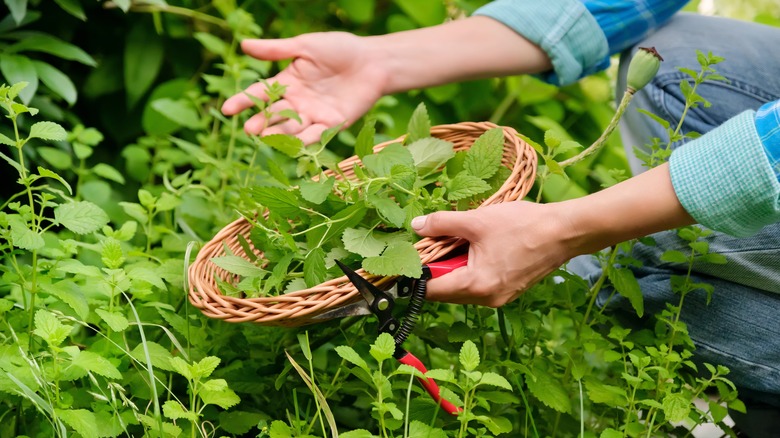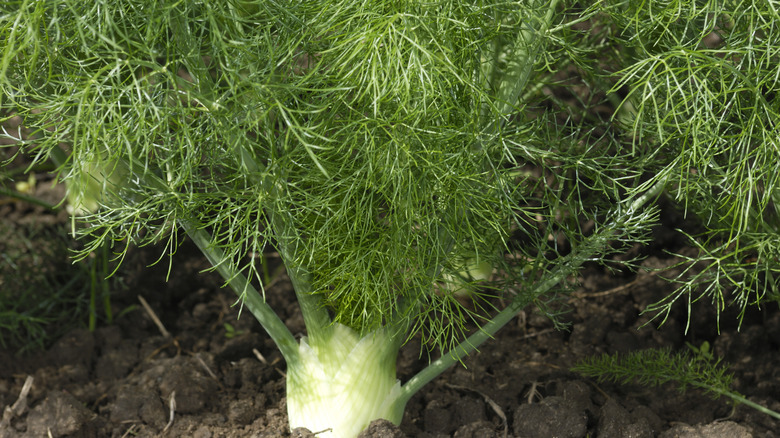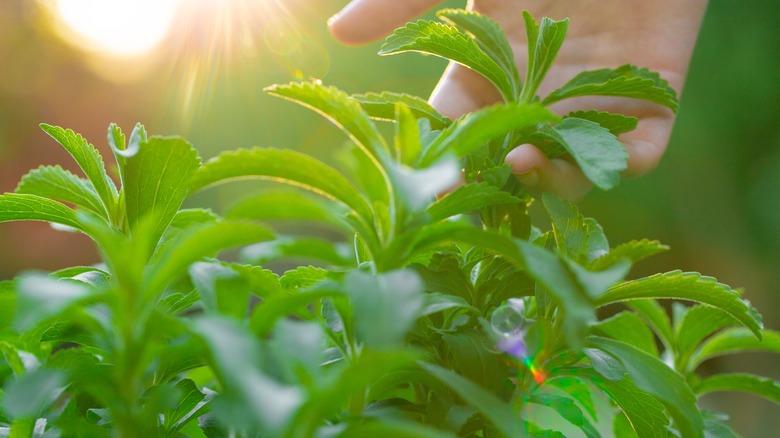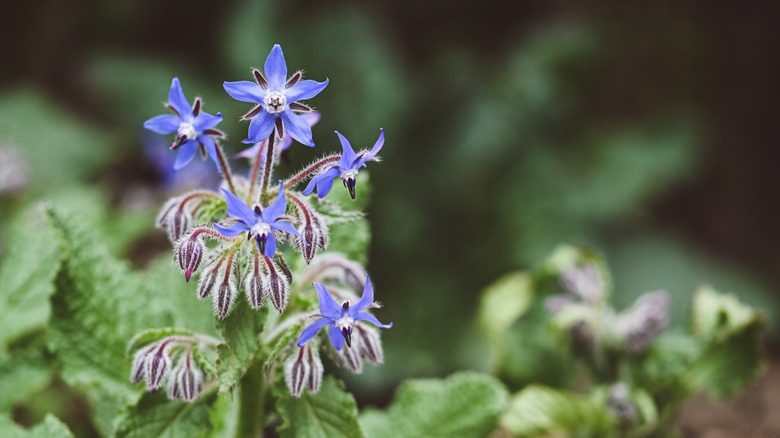Propagation is a method of growing plants from cuttings instead of seeds. It’s how rare houseplant enthusiasts get their dream plants and how you can easily grow an entire herb garden, whether indoors or outdoors, on a budget. Many herbs can be grown from cuttings, including what you buy at the grocery store. Growing more plants with these methods takes less time than starting from seeds, and it’s much easier. Seeds can be challenging for a gardening novice and they don’t always have a great success rate, while propagating from cuttings is typically much simpler and has a better chance of growing roots. To help you expand your herb garden, we’re sharing 26 delicious herbs you can easily propagate with cuttings.
The herbs on this list are packed with flavor. We’ve covered everything from sweet to savory and even spicy. Many of the species on this list are widely available and a cinch to grow so long as you meet their growing conditions. These herbs prove you don’t need to have a green thumb to have a tasty garden. We’ll let you know the best method for propagating each species, including the ones that only need to be placed in water.
1. Mint (Mentha)

Refreshing and great for fixing a tummy ache, mint propagates best in water. Fill a vessel with water — a water bottle works well. Ensure the opening of the vessel is narrow enough for the plant to sit on without falling in. Then, place the sprig, which you’ve removed the bottom leaves from, in the vessel with the stem sticking in the water. Once the sprig roots in a couple weeks, pot it in compost.
USDA Growing Zones: 3 to 8
Sun Requirements: Full sun, will tolerate partial shade
Soil Type: Moist but well-draining, pH of 6.0 to 7.0
Height: 1 to 4 feet tall
2. Parsley (Petroselinum crispum)

Parsley is one of the most beginner-friendly plants you can grow, and it’s very successful in a container. To propagate it, take the stem of the plant and cut it as close to the base as possible. Remove any leaves that will sit underneath the potting mix and plant the cutting in this medium (not soil), ensuring that it’s moist.
USDA Growing Zones: 2 to 11
Sun Requirements: Full sun
Soil Type: Well-draining with a pH of 6.0 to 7.0
Height: 9 to 12 inches tall
3. Basil (Ocimum basilicum)

Anna Klymchuk/Shutterstock
Few herbs smell as heavenly as basil. It can be grown from a 4 to 6-inch stem that’s been cut beneath a node. Trim off the bottom leaves and place the cutting in a vessel of water. Leave the vessel on your windowsill for a reasonably quick grow time. Once the roots have grown to 2 inches long, transport the plant into an indoor pot with soil.
USDA Growing Zones: 4 to 10
Sun Requirements: Full sun to partial shade
Soil Type: Moist with a pH of 6.0 to 7.0
Height: Up to 3 feet tall
4. Rosemary (Salvia rosmarinus)

Gaffera/Getty Images
You can turn store-bought rosemary into a beautiful herb garden with minimal effort. Take a sprig and remove the bottom half of the leaves with your fingers. Then, plant it in water and place it in a warm area that’s not in direct sun. Once the roots grow, repot the rosemary in sandy soil. Keep the soil moist, but be sure to let it drain completely before watering again.
USDA Growing Zones: 7 to 10
Sun Requirements: Full sun
Soil Type: Well-draining, does well in multiple soil types, pH of 6.5 to 7.0
Height: Up to 5 feet tall
5. Thyme (Thymus vulgaris)

Ana Lebiodiene/Getty Images
What is rosemary without thyme? If you have access to a healthy live plant, growing this herb is as simple as setting cuttings without the bottom leaves in water. Once they’ve grown roots, they can be moved into a pot filled with soil. However, if you’re using store-bought cuttings or sprigs from the grocery store, you’ll want to start them in soil and keep them moist and warm.
USDA Growing Zones: 5 to 9
Sun Requirements: Full sun
Soil Type: Well-draining, sandy or loamy, with a pH of 5.0 to 8.0
Height: 6 to 12 inches tall
6. Dill (Anethum graveolens)

penofoto/Shutterstock
Dill is a flavorful herb that is a cinch to propagate for beginning gardeners. Take a 3 to 4-inch cutting of new growth, remove the bottom leaves, and let it sit in water on a windowsill. Once it has sprouted roots that are at least 2 inches long, you can plant the cutting in soil.
USDA Growing Zones: 2 to 11
Sun Requirements: Full sun
Soil Type: Well-draining, rich, pH level of 5.5 to 6.5
Height: 3 to 5 feet tall
7. Oregano (Origanum vulgare)

Radovan1/Shutterstock
Oregano is a flavorful staple of Italian cuisine and deserves a spot in your garden. Plant a 3 to 4-inch cutting with the bottom leaves removed so that 2 inches remain below the soil. You can also dip it in rooting hormone before planting if desired.
USDA Growing Zones: 4 to 10
Sun Requirements: Full to partial sun
Soil Type: Well-draining, rocky or sandy, with a pH of 6.5 to 7.0
Height: 1 to 3 feet tall
8. Marjoram (Origanum majorana)

Nahhana/Shutterstock
Marjoram is a member of the mint family with a slightly-sweet, herby taste that can enhance fish, chicken, and a number of other dishes. Propagate it by taking a small cutting, stripping the bottom half of its leaves, and placing it in soil. To speed up the rooting process, add a cover for humidity. Plastic takeout containers with lids are perfect for propagating this plant.
USDA Growing Zones: 9 to 10
Sun Requirements: Full sun
Soil Type: Well-draining sandy or loamy soil with a pH of 4.9 to 8.7
Height: 1 to 2 feet tall
9. Sage (Salvia officinalis)

Gmvozd/Getty Images
Culinary sage deserves a spot in your herb garden. Unlike other plants on this list, sage should be cut from the top. Take about 4 to 6 inches of new growth from the plant. Remove the leaves from the bottom third of the cutting and place them in water or soil so they grow roots. Once the roots have reached about 2 to 3 inches in length, move them to a more permanent growing location.
USDA Growing Zones: 5 to 8
Sun Requirements: Full sun
Soil Type: Well-draining sandy or loamy with a pH of 6.0 to 7.0
Height: 24 to 36 inches tall
10. Lemon balm (Melissa officinalis)

VH-studio/Shutterstock
Layering lemon balm, typically used in tea, is the best way to propagate it. Layering involves taking a cutting and planting it in soil with a layer of soil on top. Use a stake to secure a fresh 6 to 12-inch stem of lemon balm with a small cut on the bottom side in your garden and cover it with 3 inches of soil. Roots will emerge from the cut in a couple months.
USDA Growing Zones: 3 to 7
Sun Requirements: Full sun, partial shade
Soil Type: Well-draining, rich, with a pH of 6.5 to 7.0
Height: Up to 3 feet tall
11. Catnip (Nepeta cataria)

sophiecat/Shutterstock
Give your feline friends something to smile about. Catnip is a fast-growing herb that will thrive on a windowsill, and it can also be consumed by humans in tea, though it may be best to only drink small amounts. Start a plant by snipping off a healthy leaf tip and dipping it in rooting hormone. Place the cutting in soil or water and give it direct sunlight until it grows healthy roots that can be transplanted.
USDA Growing Zones: 3 to 9
Sun Requirements: Full sun
Soil Type: Well-draining, sandy or loamy, with pH between 4.9 and 7.5
Height: 2 to 3 feet tall
12. Cilantro (Coriander)

Kritchai Chaibangyang/Getty Images
Cilantro is the same plant that’s responsible for the spice coriander (as the scientific name suggests). Cilantro refers to the stems and leaves of the plant, while coriander is made with the dried seeds. Therefore, this herb is two-in-one and perfect for small spaces. To propagate it, cut about 6 inches of new growth, trim the bottom leaves, and place it in water until it roots and can be moved to a pot.
USDA Growing Zones: 2 to 12
Sun Requirements: Full sun to partial shade
Soil Type: Well-draining and rich with a pH of 6.2 to 6.8
Height: 1 to 2 feet tall
13. Fennel (Foeniculum vulgare)

Gomezdavid/Getty Images
Fennel is a member of the carrot family with multiple culinary uses. It has an edible bulb at its base, seeds bursting with flavor, and fronds that can be added to dishes much like parsley or chives. To propagate it, place a healthy frond into water with the bottom facing down and set it on a windowsill that gets plenty of sun until it grows roots.
USDA Growing Zones: 4 to 9
Sun Requirements: Full sun
Soil Type: Well-draining and fertile, with a pH of 6.5 to 8.0
Height: Up to 6½ feet tall
14. Sorrel (Rumex acetosa)

BestPhotoStudio/Shutterstock
Sorrel is not only easy to grow but can also be planted before many other species, as it’s considered an early spring bloomer. To propagate the plant in your garden, dig around it and divide the roots by hand, then plant them separately. Ensure that each of the roots has at least one healthy leaf.
USDA Growing Zones: 5 and higher
Sun Requirements: Full sun
Soil Type: Well-draining with organic matter and a pH of 5.5 to 6.8
Height: 12 to 18 inches tall
15. Tarragon (Artemisia dracunculus)

Mrybski/Getty Images
French tarragon has an earthy flavor and an aroma that herb gardeners adore. It’s best propagated with cuttings from new stems. Cut a 4 to 6-inch stem and strip the bottom third of its leaves. Plant the cutting in potting mix and place it where it’ll receive indirect sunlight with periods of shade. You can also dip it in rooting hormone to give it a better chance of growing strong.
USDA Growing Zones: 4 and higher
Sun Requirements: Partial sun, partial shade
Soil Type: Well-draining, light soil with a pH between 6.5 and 7.5
Height: 2 to 3 feet tall
16. Summer savory (Satureja hortensis)

Adelart/Getty Images
Though it’s not as widely known as oregano or cilantro, summer savory is less bitter and more peppery than winter savory. Propagate this low-maintenance plant by taking a fresh cutting about 4 to 5 inches long. Remove the bottom ⅓ of the leaves and place it in water or soil. Once it forms roots that are longer than 2 inches, you can move it to a grow pot or garden.
USDA Growing Zones: 1 to 11
Sun Requirements: Full sun
Soil Type: Well-draining, rich soil with a pH of 6.6 to 7.5
Height: 1 to 2 feet tall
17. Lavender (Lavandula)

nieriss/Shutterstock
Yes, you can eat lavender. In fact, it has an incredible flavor that’s unlike any other herb on this list. Queen Victoria even preferred lavender jelly over traditional flavors. There are multiple ways to propagate lavender, including with cuttings from the new growth on top of the plant. Or, if temperatures have begun to drop, you can cut a thicker branch and strip the side leaves off. Planting the cutting in soil will be more effective than placing it in water.
USDA Growing Zones: 5 to 10
Sun Requirements: Full sun
Soil Type: Well-draining with a pH of 6.7 to 7.3
Height: Up to 2 feet tall
18. Stevia (Stevia rebaudiana)

yul38885/Shutterstock
Give in to your sweet tooth with this sugar alternative. Stevia can be grown from a small cutting. It does best when dipped into root growth hormone prior to planting. Add the cutting into moist sand, a soil medium, or soil and keep the plant humid. Covering the plant is the best way to keep it moist.
USDA Growing Zones: 9 to 11
Sun Requirements: Full sun to dappled sun
Soil Type: Well-draining and rich with a pH of 6.7 to 7.2
Height: 1 to 2½ feet tall
19. Chamomile (Matricaria chamomilla)

Aimintang/Getty Images
Chamomile is a favorite herb for tea drinkers everywhere. If you want to propagate the plant, begin by watering it deeply. Then, after it’s soaked, find a stem with lots of leaves but no bloom and dig around the base, cutting the clipping ½ of an inch below the soil line. Place the bottom 2 inches of the cutting into a soil and perlite mixture.
USDA Growing Zones: 4 to 9
Sun Requirements: Full sun
Soil Type: Well-draining with a pH of 5.6 to 7.5
Height: 3 to 6 feet tall
20. Bay laurel (Laurus nobilis)

Danny Hummel/Shutterstock
Bay laurel may not be fit for a small indoor herb garden, but it’s worth growing if you have the space and love the flavor of bay leaves. Take a leafy cutting from a healthy yet older node in the late summer. Strip the bottom half of the leaves from the stem. Start the bay laurel inside by dipping the stem into rooting hormone and planting it in a growing medium, keeping it out of direct sun.
USDA Growing Zones: 8 to 10
Sun Requirements: Full sun, partial sun
Soil Type: Well-draining with a pH between 4.5 and 8.3
Height: 10 to 60 feet tall
21. Borage (Borago officinalis)

The goldfinch/Shutterstock
If you’ve never tried borage, you should. It has a light taste like cucumber and can be eaten or used as an attractive garnish. In large quantities, it may cause gastrointestinal distress, but it’s considered to have a low toxicity and is safe to consume. You can propagate this plant by trimming a cutting, removing the bottom leaves, dipping it in rooting hormone, and placing it in sandy soil.
USDA Growing Zones: 2 to 11
Sun Requirements: Full sun, partial sun
Soil Type: Well-draining with a 4.5 to 8.5 pH level
Height: 1 to 3 feet tall
22. Calendula (Calendula officinalis)

BushAlex/Shutterstock
Not only does Calendula look gorgeous, but the flowers and leaves are edible, too. It’s even used to give certain cheeses their yellow color. Growing your own calendula starts with a stem cutting from a healthy plant. You can dip it in root hormone powder to help it grow faster, but it isn’t necessary. Simply plant the cutting in a potting mix so it can grow roots. Once roots have formed, transfer the flower into a grow pot or the ground.
USDA Growing Zones: 2 to 11
Sun Requirements: Full sun, partial sun
Soil Type: Well-draining with a pH of 6.0 to 7.0
Height: 1 to 2 feet tall
23. Angelica (Angelica archangelica)

eric1207cvb/Shutterstock
Angelica has a flavor like licorice and has been used in cooking for centuries. Moreover, it has medicinal properties that can improve sinusitis, headaches, colds, and several other ailments. You’ll have the best luck from dividing a mature plant. To do this, dig up the roots and separate them into a few sections, then replant them in the ground. However, ensure you don’t harm the taproot, as this could cause the propagated plants to die.
USDA Growing Zones: 4 to 9
Sun Requirements: Full sun, partial shade
Soil Type: Rich, light, well-draining with a pH of 7.0 to 8.0
Height: 3 to 7 feet tall
24. Caraway (Carum carvi)

Dajra/Shutterstock
Caraway seeds have a unique taste with notes of licorice, anise, and nuttiness and are usually used in rye bread. Propagate the plant by taking a healthy cutting from an established, mature plant. Cut near the base of the plant and strip the leaves from the bottom ⅓ of the stem. Place the cutting in moist growing medium out of sunlight and wait for the roots to grow before transplanting the cutting into soil.
USDA Growing Zones: 4 to 10
Sun Requirements: Prefers full sun, will tolerate partial shade
Soil Type: Sandy, well-draining with a pH of 6.0 to 7.0
Height: Up to 2 feet tall
25. Turmeric (Curcuma longa)

johan kusuma/Shutterstock
Few herbs are as beloved as turmeric, and that’s for good reason. Also known as “The Golden Spice,” turmeric not only makes your food taste heavenly but it is widely accepted as an anti-inflammatory. Do yourself a favor and cut some healthy 3-inch rhizomes off a mature plant. Let them dry out for a few days, then place them 2 to 4 inches deep with the bud facing upwards and layer more soil over the top.
USDA Growing Zones: 8 to 11
Sun Requirements: Full sun, partial shade
Soil Type: Loose, sandy, and well-draining with a pH of 6.0 to 6.5
Height: Up to 3 feet tall
26. Horseradish (Armoracia rusticana)

iva/Shutterstock
If you are searching for an herb with lots of flavor, you ought to grow horseradish. The roots are used in the popular condiment of the same name. If you want to propagate this plant, dig it up and separate the root into four pieces. A few days later, plant the pieces with the crown 1 to 2 inches below the ground level.
USDA Growing Zones: 3 to 9
Sun Requirements: Prefers full sun, tolerates partial shade
Soil Type: Rich, well-draining with a pH of 6.0 to 7.5
Height: Up to 2 feet tall




